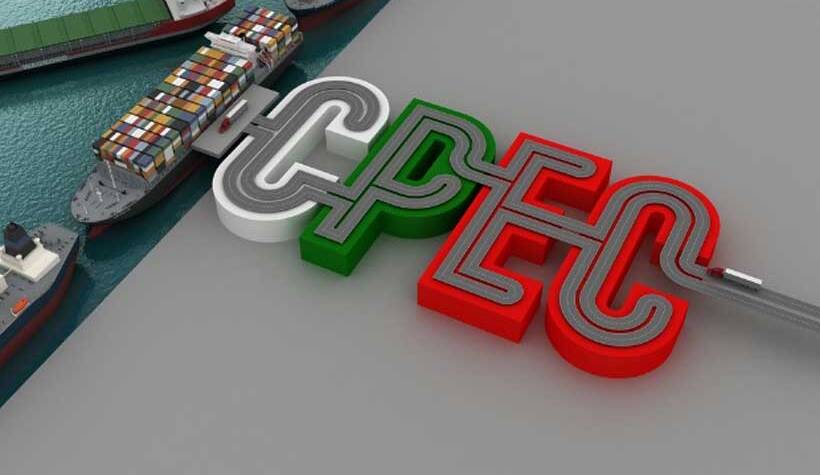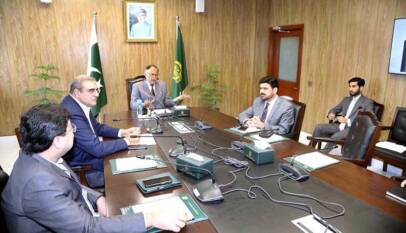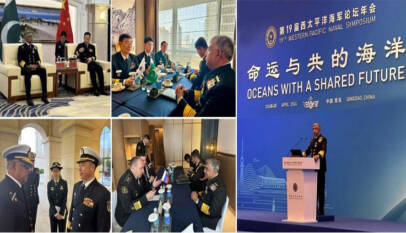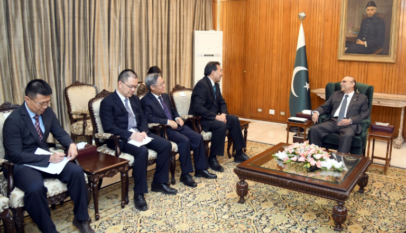CPEC marks 10th anniversary of substantial achievements in Pakistan’s development
Dr. Muhammad Ali Shaikh, a social scientist specializing in development communication, discusses the Belt and Road Initiative (BRI), previously known as One Belt-One Road (OBOR). Introduced by Chinese President Xi Jinping in 2013, the initiative aims to establish an extensive network of infrastructural connections across continents, linking China with markets in Asia, Europe, and Africa. Among its flagship projects is the China-Pakistan Economic Corridor (CPEC), which connects Kashgar in China to Gwadar in Pakistan. Initially, CPEC encountered obstacles due to political unrest in Pakistan. Despite initial concerns regarding transparency and project selection, CPEC made significant progress until 2017 but experienced a slowdown following changes in Pakistani leadership. Recommendations for CPEC 2.0 include prioritizing transparency, involving stakeholders, considering environmental impacts, and fostering consensus for sustainable development. Despite challenges, CPEC remains crucial for Pakistan’s development, necessitating the resolution of its shortcomings to achieve optimal results.
It was in 2013 that Chinese President Xi Jinping unveiled two highly ambitious international development programmes, the ‘Silk Road Economic Belt’, which he announced during his visit to Kazakhstan in September, and the ‘21st Century Maritime Silk Road Development Strategy’, announced a month later in Indonesia. Jointly, they were termed as ‘One Belt-One Road’ (OBOR), and later as the ‘Belt and Road Initiative’ (BRI).
The initiative envisaged the development of a vast network of infrastructural connections across the continents, both overland and maritime, connecting China more closely with Asian, European and African markets. In BRI, the ‘Belt’ comprised six overland economic corridors, while the maritime ‘Road’ connected Chinese ports with ports in Southeast Asia, South Asia, Middle East and Africa. It is also sometimes called the “String of Pearls.”
Among the six economic corridors, one is the China-Pakistan Economic Corridor (CPEC), which connects the city of Kashgar, at the foot of the Pamir Mountains in western China, to the Gwadar port on the Indian Ocean in southern Pakistan, traversing a distance of about 2,700 kilometres. Gwadar, being a part of both the maritime and overland components of BRI, prompted President Xi to term Pakistan as a country where both “the Silk Road Economic Belt and the 21st Century Maritime Silk Road meet.”
In view of its importance, the CPEC was designated as the ‘flagship’ programme of the BRI and is the largest strategic and economic initiative undertaken by China outside its borders.
INITIAL ROADBLOCKS
In Pakistan, the Pakistan Muslim League-Nawaz (PML-N) had formed the government at the centre, with Nawaz Sharif as the prime minister. One of the main opposition parties, the Pakistan Tehreek-i-Insaf (PTI), led by Imran Khan, refused to accept the 2013 elections results, alleging that they were rigged in favour of the PML-N.
Things came to a head in August 2014, when the PTI and the Pakistan Awami Tehreek (PAT) staged a dharna or sit-in in front of the Parliament House in Islamabad, where tens of thousands of their supporters assembled.
Incidentally, this was just a few weeks before the Chinese president’s scheduled visit to Islamabad in September 2014, where he was expected to formally launch the CPEC project. The Chinese expressed their reservations regarding the president’s visit while the dharna was taking place. Upon this, the government requested the PTI and the PAT to end the protest, but they refused. Instead, they proposed that the protesters welcome President Xi by holding Chinese flags. This did not fly with the Chinese, resulting in a cancellation of the visit.
The dharna ended in December, paving the way for President Xi’s visit to Islamabad a few months later, in April 2015. During his visit, he addressed the joint session of the Pakistani parliament, in which he termed the CPEC as the “focal point” between the two countries. On that occasion, the two countries signed 51 agreements and memorandums of understanding, to the tune of $46 billion, which was a much larger figure than the $28 billion contemplated at the time of his postponed visit in September 2014.
SCOPE OF THE PROJECT
President Xi broadly elaborated the extent and scope of the CPEC in his officially released article ‘China-Pak Dosti Zindabad’, coinciding with his Pakistan visit. He wrote that the project would “form a ‘1+4’ cooperation structure with the Economic Corridor at the centre, with the Gwadar Port, energy, infrastructure and industrial cooperation being the four key areas.” The President also hinted on expansion of the scope in future, stating that the “planning and layout of the Economic Corridor should cover other parts of Pakistan as well.”
Among the four priority sectors spelled out by the Chinese president, the topmost was the development of Gwadar as a deep sea port of international standards. The projects envisaged included dredging, the development of the port and the free trade zone, the construction of breakwaters, the construction of an international airport, the development of facilities and infrastructure for the provision of fresh water, including installation of desalination plants, etc.
Next on the priority list was power generation, utilising a variety of resources, ranging from coal to hydel to wind to solar. In view of the prevalence of prolonged periods of power outages, the goal was to add several thousand megawatts to the national grid. In addition to power generation, the project also had a component relating to the construction of power transmission lines.
Further down the line was a set of ‘connectivity’ projects, envisaging the construction of motorways, highways and railway networks. It also had a project relating to digital connectivity, by laying fibre-optic cables between the two countries, with future prospects of connecting Pakistan to the Chinese space satellite system.
Then came the set of projects relating to the establishment of ‘special economic zones’ (SEZs), where a liberal package of concessions and incentives was to be granted to promote industrialisation in the country. Several sites were identified from which, initially, nine were selected.
The entire programme was divided into three five-year phases, from 2015 to 2030. The first phase (2015-2020) was divided into two subphases: the “early harvest” projects, which were to be completed before the 2018 elections, followed by the “short-term” projects to be completed till 2020. The second phase (2020-2025) envisaged the establishment of SEZs, while the last phase (2025-2030) had a much wider canvas for cooperation, in areas from agriculture to tourism.
While ambiguity remains about the financial size of the CPEC project, it was initially said to be around $46 billion. But with the ongoing addition of projects, the figure being quoted soon reached $62 billion, while some experts even cited $100 billion. The mode of funding comprised three streams: direct grants, government-to-government loans, and corporate financing.
Amid a total blackout of financial information in the public domain, international sources indicate that direct grants account for about 10 percent of the original package, mostly meant for the development of Gwadar. The government-to-government loans comprise about 20 percent of the programme funding, which are primarily meant for developing transport infrastructure. Most of the remaining 70 percent comes from China in the form of corporate financing on commercial interest rates, mostly meant for energy infrastructure.
It warrants mention that the programme serves Chinese interests equally and is not just an act of benevolence on part of China for Pakistan, as many in Pakistan tend to believe. The project serves multiple Chinese interests. Firstly, it connects China with the Indian Ocean, which provides it an easy access to the Middle East markets and beyond. Then, it further opens Pakistan’s 250-million strong market for Chinese goods and services, as well as business opportunities for Chinese companies to undertake most of the CPEC contracts. Additionally, it also increases the prospects of exploration and utilisation of Pakistan’s virgin mineral and land resources.
Last but not the least, China’s presence through the CPEC at Gwadar, located just 600 kilometres from the Strait of Hormuz, at the gates of the Gulf of Oman, has the strategic potential of serving as its ‘backdoor’ for trade and energy, in case tensions in the South China Sea escalate.
FEARS AND CONCERNS
While the project has been largely portrayed as a panacea for all the ills and evils plaguing Pakistan, there have been fears and doubts as well in various sections of society. The first and foremost concern has been about the almost complete opacity of the CPEC. Weary of what had happened to the Hambantota port in neighbouring Sri Lanka in 2015, people want to know the extent and the terms and conditions of Pak-China financial agreements.
Voicing concerns about the lack of transparency, the then governor of the State Bank of Pakistan, Ashraf Mahmood Wathra, had lamented in 2015 that, “I don’t know, out of the $46 billion, how much is debt, how much is equity, and how much is in-kind.” If the governor of the State Bank does not have information, what can be said about the rest of the country’s citizens?
Another major concern, primarily born out of opacity, is regarding the selection of projects under the CPEC umbrella. For instance, very serious concerns and questions were raised regarding the establishment of the 1,320-megawatt (MW) coal-fired power plant in Sahiwal in central Punjab.
This power plant was designed to operate on imported coal, which was to be imported from Indonesia and South Africa to Karachi’s Port Qasim by ships, and then had to be carried inland through trains to the lush green agriculture-intensive areas of Sahiwal, about 1,000 kilometres away. This creates a set of ecological, environmental, economic and operational issues.
Yet another cause of concern is that the execution of almost all the projects went to Chinese contractors, who brought in most of their executive and technical manpower from China, except low-tier staff that was recruited locally. The question raised is that, when Pakistanis have to foot the bill of these projects, why are they being denied business and employment opportunities.
A significant segment of the business community has concerns regarding the SEZs. An important segment of traders believes that 2006’s free trade agreement with China had resulted in an explosion of Chinese exports at the cost of locally manufactured products. They also fear that Chinese companies would be offered preferential terms, which would leave them at a disadvantageous position.
THE OUTCOME
The CPEC projects went ahead at full steam for the first two years, till 2017. However, things changed with the removal of the greatest proponent of CPEC, Nawaz Sharif, from the office of the prime minister.
The following year saw the PTI in government, with Imran Khan as the prime minister. While the PTI was not against the project, it had reservations over the manner in which it had been implemented — “too Punjab-centric, not enough benefit for Pakistani businesses, not green enough, poorly negotiated, and probably corrupt,” wrote Andrew Small while quoting PTI leaders in his book The China-Pakistan Axis: Asia’s New Geopolitics.
In his victory speech, while Imran Khan spoke about China and the CPEC, his emphasis was on learning from China and “how they brought 700 million people out of poverty.” He also wanted to learn from them about the measures they had taken to eliminate corruption, and particularly “how they had arrested more than 400 ministers [on corruption charges] there.” He did not speak about the mega projects under the CPEC, which was interpreted as his reservations on the manner in which the project had been implemented.
Shortly afterwards, the adviser to the prime minister on commerce, Abdul Razak Dawood, in an interview with the Financial Times, stated that Pakistan needed to review and renegotiate the CPEC project. He even suggested freezing the programme for a year or so to re-evaluate it in its entirety.
These developments considerably slowed down the implementation and expansion of the programme, with efforts to speed it up resuming only after the ouster of the PTI government in 2022.
Still, the last decade of CPEC has added about 510 kilometres of motorways and highways, in addition to the generation of about 6,000 megawatts of electricity, and foreign direct investment of about $25.4 billion, according to a report titled “Ten Years of CPEC”, published by the Institute of Strategic Studies Islamabad (ISSI).
THE ROAD AHEAD
Recently, there has been talk of CPEC 2.0. It is necessary that we should draw lessons from our earlier experiences. Firstly, there is a need to bring transparency to the entire programme, from the conceptualisation of the projects till their operation. Secondly, stakeholder involvement is essential for sustainability of any development project, which has been badly neglected so far in the CPEC.
Thirdly, Pakistan should understand very well that any programme that brings in excessive dependency on any other nation is not good for the country. The best course of action is to limit the programme to a modest size, and to carry it out at its natural pace, without much fanfare, to avoid political bickering.
Fourthly, it would be well advised for Pakistan to give due consideration to environmental concerns during the selection of the projects, particularly considering the threats posed by climate change.
Finally, the country would be very well served if a consensus is built beforehand regarding the various projects of the programme, instead of adopting a ‘top-down’ approach, which always results in adverse situations.
In conclusion, the CPEC project still has great potential for the development of Pakistan, provided its weaknesses are removed.
CPEC and Kazakhstan’s vital role in regional trade
The Republic of Kazakhstan has opened doors for the expansion of trade with Pakistan that …












